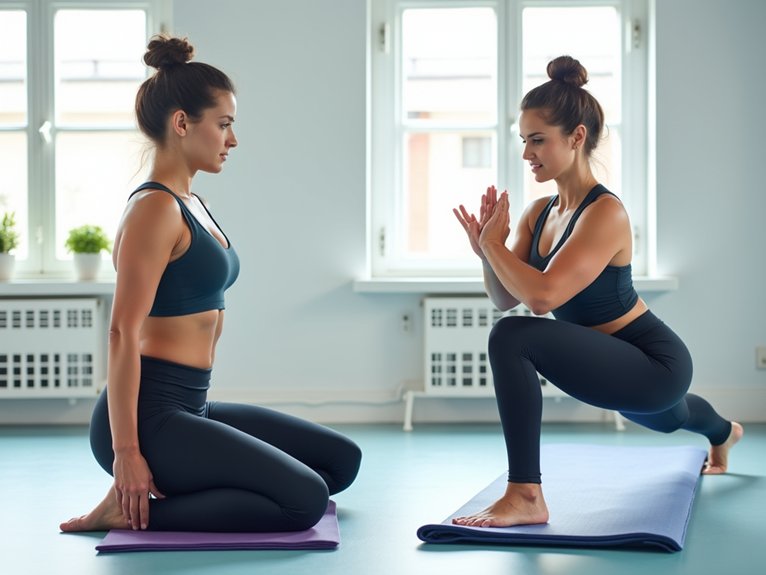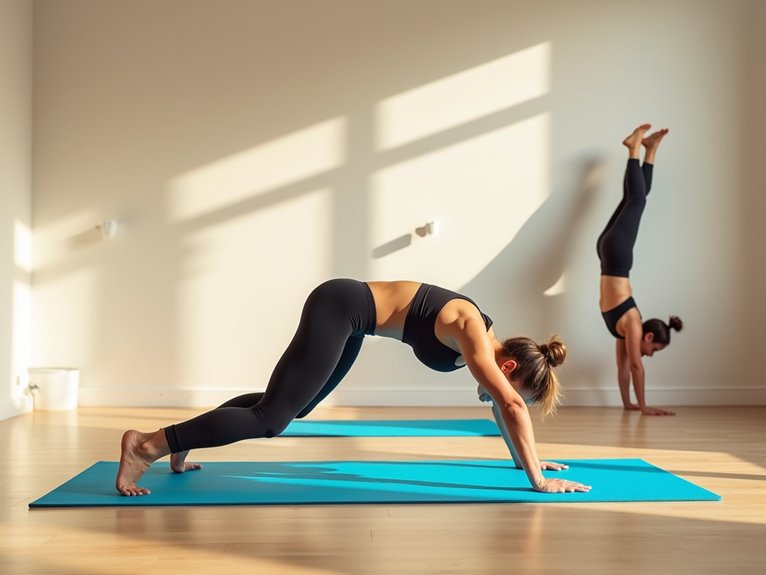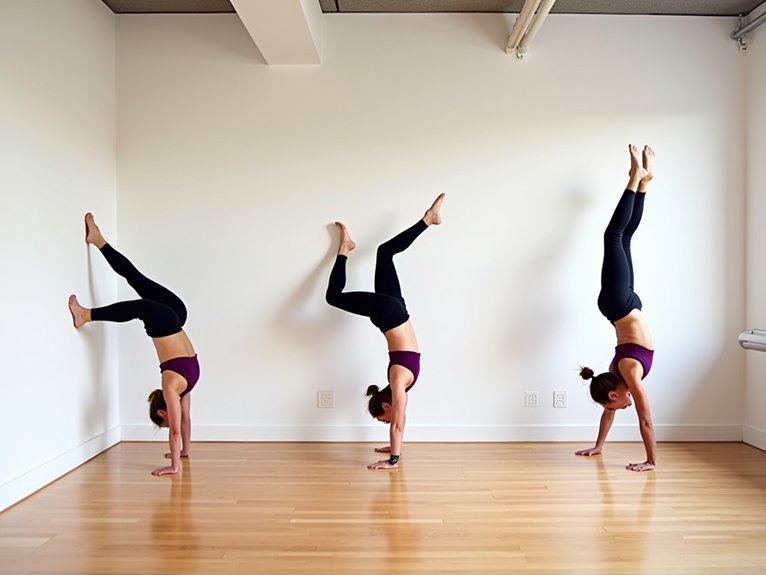Learning to stand on your hands requires progressive training. Start with wrist/shoulder preparation exercises and wall supports to build foundational strength. Practice proper alignment with hands shoulder-width apart and joints stacked vertically. Incorporate core strengthening exercises like planks and hollow holds. Progress to controlled kick-ups and balance drills, practicing regularly in short sessions. Gradually work toward freestanding handstands using toe-pulls and heel-pulls. The following steps will transform this challenging skill into an achievable goal.
Building the Essential Foundation: Wrist and Shoulder Preparation

Before attempting a handstand, proper wrist and shoulder preparation is imperative for both safety and success. Practitioners should begin with gentle wrist circles and flexion/extension exercises to mobilize these vital joints. Follow with wrist stretches, holding each position for 20-30 seconds.
For shoulders, focus on developing stability and range of motion through wall slides, scapular push-ups, and thoracic spine mobility exercises. Shoulder dislocates using a resistance band help improve overhead positioning.
Consistent preparation prevents injuries and builds the foundation for proper handstand alignment. Spend at least 5-10 minutes on these exercises before each practice session to guarantee the joints can handle weight-bearing in an inverted position.
Mastering Wall Supports and Kick-Ups
After completing wrist and shoulder preparation, students should progress to wall supports and kick-ups, which form the pivotal intermediate steps before attempting freestanding handstands.
For wall supports, practitioners position themselves facing away from a wall, place hands shoulder-width apart on the floor, and walk feet up the wall. Beginners should hold this position for 30-60 seconds, focusing on proper alignment—shoulders over wrists, engaged core, and straight body line.
Kick-ups involve placing hands on the floor, kicking one leg upward while pushing off with the other. Practice controlled kicks, gradually increasing height until reaching vertical position. The wall provides safety during this learning phase.
Core Strengthening Exercises for Handstand Stability

A strong core serves as the foundation for handstand stability, enabling practitioners to maintain proper alignment and balance while inverted. Several targeted exercises effectively develop this essential strength.
Planks build overall core endurance, while hollow body holds specifically train the anterior chain needed for handstand alignment. Practitioners should incorporate V-ups and hanging leg raises to develop the hip flexors and lower abdominals.
For rotational stability, side planks and Russian twists prove valuable. Advanced students benefit from adding straddle compression exercises and L-sits to their routine. Consistent practice of these exercises, 2-3 times weekly, dramatically improves handstand performance.
Proper Alignment Techniques for Balance
Building upon core strength, mastering proper alignment creates the structural foundation for successful handstands.
Practitioners should focus on stacking joints vertically: wrists, shoulders, hips, and ankles form one straight line. Hands should be placed shoulder-width apart, fingers spread wide for stability. The shoulders must be fully extended, pushing away from the floor to create space between ears and shoulders.
Common alignment errors include arched backs, splayed elbows, and incorrect head positioning. To correct these issues, practice against a wall, using a mirror, or with a spotter who can provide feedback. Proper alignment reduces strain on joints while maximizing balance potential through ideal weight distribution.
Progressing to Freestanding Handstands

Shifting from wall-supported handstands to freestanding practice requires systematic progression and consistent effort. Practitioners should begin with toe-pulls, where they position themselves in a wall handstand and gently pull one or both feet away, balancing momentarily before returning.
The next stage involves heel-pulls, performing controlled kicks to handstand position with just enough momentum to achieve vertical alignment. Spotters can provide assistance by supporting the legs.
Balance drills, such as fingertip adjustments and shoulder positioning, help develop the proprioception needed for stability. Regular practice of 10-15 minute sessions is more effective than occasional longer workouts.
Common Mistakes and Troubleshooting Tips
Many handstand practitioners encounter the same fundamental errors that hinder their progress toward mastering this challenging skill. Common mistakes include arched backs, splayed legs, and looking at the floor instead of between the hands. Practitioners often rely too heavily on wrist strength while neglecting core engagement.
When troubleshooting, focus on proper alignment: shoulders stacked over wrists, hips over shoulders, and legs together. If balance remains elusive, practice heel pulls against a wall. For wrist pain, gradually increase practice duration and use proper warm-ups. Remember that inconsistent practice typically causes plateaus—maintaining a regular training schedule accelerates progress dramatically.



